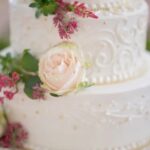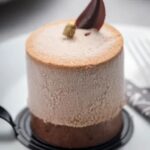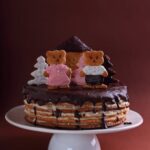Are you looking to learn how to decorate a plain white cake? Decorating a plain white cake can be a fun and creative way to showcase your baking skills. From essential tools and ingredients to more advanced decorative techniques, this article will guide you through the process of turning a simple white cake into a stunning masterpiece.
Plain white cakes may seem basic, but they serve as a blank canvas for creativity and personalization. Whether you’re a beginner or an experienced baker, there are countless ways to transform a plain white cake into an eye-catching dessert that is sure to impress your guests.
In this article, we will explore the essential tools and ingredients needed for cake decorating, as well as the right frosting options for your plain white cake. Additionally, we’ll discuss basic decorating techniques for beginners and how to elevate your design with fresh fruits, berries, edible flowers, chocolate, nuts, and custom decorative touches. Get ready to unleash your creativity and master the art of decorating a plain white cake.
Essential Tools and Ingredients for Cake Decorating
Decorating a plain white cake can be a fun and creative process, but having the right tools and ingredients is essential for a successful outcome. Whether you’re a beginner or an experienced baker, having the following items on hand will make the decorating process much easier:
- Decorating Tips: Invest in a set of high-quality decorating tips to create different designs and patterns with frosting. Round tips are great for creating outlines and lettering, while star tips are perfect for making rosettes and swirls.
- Piping Bags: Disposable or reusable piping bags are essential for applying frosting to your cake. They come in various sizes, so it’s a good idea to have a few on hand for different projects.
- Offset Spatula: An offset spatula is useful for spreading frosting evenly across the surface of the cake and achieving smooth edges. It’s also handy for creating textured patterns in the frosting.
- Food Coloring: If you want to add color to your cake design, having a set of gel-based food coloring will give you vibrant results without altering the consistency of your frosting.
When it comes to ingredients, using high-quality butter, eggs, flour, sugar, and flavorings will impact the taste and texture of your cake. Additionally, choosing the right type of flour (all-purpose or cake flour) and leavening agents (baking powder or soda) will ensure that your cake turns out light and fluffy. With these essential tools and ingredients in your baking arsenal, you’ll be well-equipped to create beautifully decorated plain white cakes that are sure to impress.
Choosing the Right Frosting for Your Plain White Cake
When it comes to choosing the right frosting for your plain white cake, there are several options to consider. One popular choice is buttercream frosting, which is creamy, smooth, and easy to work with. This type of frosting can be flavored and colored in endless ways, allowing you to customize the taste and appearance of your cake.
Another option is cream cheese frosting, which has a tangy flavor that pairs well with the sweetness of a plain white cake. Ganache, a rich mixture of chocolate and cream, is perfect for adding a decadent touch to your cake.
Before choosing a frosting, it’s important to consider the climate and conditions where the cake will be served. For warmer temperatures, a stable frosting like Swiss meringue buttercream or fondant may be more suitable to prevent melting or drooping. Additionally, take into account the preferences of the person or people who will be enjoying the cake. Some might prefer a lighter and fluffier frosting like whipped cream, while others might enjoy the richness of ganache.
Ultimately, the choice of frosting for your plain white cake should complement its flavor and design. Consider experimenting with different frostings to find the perfect match for your creation and don’t be afraid to mix and match flavors and textures for a truly unique experience. With the right frosting, your plain white cake will become a canvas for delicious creativity.
Basic Cake Decorating Techniques for Beginners
Decorating a cake can be an enjoyable and creative process, especially for beginners. The key to successful cake decorating is starting with the right tools and techniques. One of the essential tools for basic cake decorating is a turntable, which allows for easy and smooth frosting application. Additionally, having an offset spatula and a bench scraper will help ensure that your frosting is spread evenly across the cake.
Once you have the necessary tools, it’s important to learn some basic cake decorating techniques. One simple yet effective technique is creating a smooth frosting surface.
This can be achieved by applying a thin layer of frosting, known as a crumb coat, allowing it to set in the refrigerator, and then adding another layer of frosting on top. Another beginner-friendly technique is piping borders around the top and bottom edges of the cake using a piping bag and different tips for various decorative designs.
For those new to cake decorating, practicing with buttercream frosting is recommended due to its forgiving nature. It can easily be manipulated into various textures such as rosettes, swirls, and even simple flowers. With these basic techniques in mind, beginners can start experimenting with different designs before advancing to more complex decorative methods.
| Basic Cake Decorating Techniques | Description |
|---|---|
| Smooth frosting surface | Applying crumb coat before final layer. |
| Piping borders | Using piping bag to create decorative edges. |
| Buttercream flowers | Simple flower designs using buttercream frosting. |
Adding a Pop of Color
Fresh fruits and berries can add a burst of natural color and a refreshing taste to your plain white cake. Not only do they provide visual appeal, but they also offer a contrast in flavor and texture that can take your cake to the next level. Some popular options for decorating with fresh fruits and berries include strawberries, blueberries, raspberries, blackberries, kiwi slices, and pineapple chunks.
When using fresh fruits and berries to decorate your cake, it’s important to consider the ripeness and sweetness of the fruits. Ripe, juicy fruits will not only look more appealing on the cake but will also provide a delicious burst of flavor with each bite. Additionally, consider the seasonality of the fruits you choose to ensure that they are at their peak freshness and flavor.
To incorporate fresh fruits into your cake design, you can arrange them in a pattern on top of the cake or around the perimeter. Alternatively, you can layer sliced fruits between each cake layer for a colorful surprise when the cake is cut. Another option is to create an attractive fruit compote or fruit glaze to drizzle over the top of the cake for added moisture and flavor.
Using fresh fruits and berries as part of your cake decoration not only adds visual interest but also provides a healthy and vibrant element to your dessert. Whether you opt for a simple arrangement of strawberries on top or an intricate design incorporating multiple types of fruit, adding a pop of color with fresh fruits and berries is sure to impress your guests and elevate your plain white cake to a work of art.
| Popular Fruits for Cake Decoration | Tips for Using Fresh Fruits |
|---|---|
| Strawberries | Choose ripe, juicy fruits for maximum flavor |
| Blueberries | Consider seasonality for peak freshness |
| Raspberries | Create patterns or layers with sliced fruits |
Elevating Your Cake Design With Edible Flowers
When it comes to decorating a plain white cake, adding edible flowers can take your design to the next level. Not only do edible flowers add a pop of color and visual appeal to your cake, but they also bring a delightful aroma and subtle flavor that can enhance the overall taste of your creation. Here are some tips on how to incorporate edible flowers into your cake decoration:
1. Selection: Choose edible flowers that are organic and free from pesticides. Some popular choices include roses, lavender, violets, pansies, and nasturtiums. Ensure that the flowers are thoroughly cleaned and free from dirt or insects before using them on your cake.
2. Placement: When placing edible flowers on your cake, consider the overall design and placement of each flower. You can opt for a simple scattered look for a whimsical touch or create an intricate pattern by strategically placing each flower for a more elegant finish.
3. Safety: It’s important to ensure that the flowers you use are safe for consumption. Avoid using flowers from florists or garden centers, as they may have been treated with chemicals not suitable for consumption. Always research which flowers are safe to eat and consult with a professional if you’re uncertain about a specific flower.
By incorporating edible flowers into your cake decorating repertoire, you can elevate the design of your plain white cake with minimal effort while adding a sophisticated touch that will impress your guests. Whether you’re aiming for a rustic-chic look or an elegant finish, edible flowers offer endless possibilities for creating stunning cake designs that are both visually appealing and delicious.
Incorporating Chocolate and Nuts for a Decadent Twist
Incorporating chocolate and nuts into your plain white cake can take it to the next level, adding a decadent twist that will have your guests coming back for more. Whether you’re a fan of rich, velvety chocolate or the crunch of toasted nuts, there are countless ways to incorporate these delicious ingredients into your cake design.
Chocolate Ganache Drizzle
One simple yet luxurious way to incorporate chocolate into your plain white cake is by drizzling it with a luscious chocolate ganache. Made with just two ingredients – chocolate and heavy cream – ganache adds an elegant touch to any dessert. Once the ganache is made, allow it to cool slightly before gently pouring it over the top of your cake, letting it cascade down the sides for a beautiful finish.
Nutty Crumb Topping
For those who enjoy a bit of texture in their desserts, adding a nutty crumb topping to your plain white cake can provide a satisfying crunch. Simply chop up your favorite nuts – such as almonds, pecans, or walnuts – and mix them with sugar and melted butter to create a delectable crumble. Sprinkle this mixture over the top of your frosted cake before serving.
Chocolate Shavings and Nut Clusters
Another visually stunning way to incorporate chocolate and nuts into your cake design is by decorating with chocolate shavings and nut clusters. Use a vegetable peeler to create delicate curls of chocolate from a bar of semi-sweet or dark chocolate, then arrange them on top of the frosting for an elegant presentation.
Additionally, you can create clusters of nuts by melting together chocolate and chopped nuts before forming small mounds on parchment paper to set. Once hardened, these clusters can be placed strategically around the edges of your cake for a sophisticated touch.
With these decadent additions, your plain white cake will become an irresistible masterpiece that combines the best elements of simplicity and indulgence.
Personalizing Your Cake With Custom Decorative Techniques
When it comes to decorating a plain white cake, there are endless possibilities for adding a personal touch to your creation. Whether you’re celebrating a birthday, anniversary, or any other special occasion, custom decorative techniques can make your cake truly unique and memorable.
Using Fondant and Gum Paste
One popular way to personalize a plain white cake is by using fondant and gum paste to create intricate designs. These pliable materials can be molded and shaped into various shapes, such as flowers, figures, or geometric patterns. With the use of fondant cutters and molds, you can add a professional finish to your cake that will impress your guests.
Airbrushing and Stenciling
For those looking to take their cake decorating skills to the next level, consider using an airbrush kit or stencils to add intricate designs and patterns to your plain white cake. Airbrushing allows for smooth color transitions and shading effects, while stencils provide a quick and easy way to create detailed designs with icing or edible paint.
Piping Techniques
Another way to personalize your cake is by using piping techniques to write messages, create borders, or add decorative details. With the use of different piping tips and icing colors, you can let your creativity shine through by adding personalized touches that reflect the theme or purpose of the celebration.
By incorporating these custom decorative techniques into your cake decorating repertoire, you can elevate a plain white cake into a stunning work of art that reflects your personal style and creativity. With practice and experimentation, you can master the art of custom cake decoration and impress your friends and family with beautiful and delicious creations for any occasion.
Conclusion
In conclusion, decorating a plain white cake can be a fun and rewarding experience for both beginner and experienced bakers alike. By mastering the essential tools and ingredients for cake decorating, choosing the right frosting, and learning basic techniques, anyone can create a stunning and personalized dessert. Fresh fruits, edible flowers, chocolate, nuts, and custom decorative techniques offer endless possibilities for adding visual interest and delicious flavor to your cake.
To truly master the art of decorating a plain white cake, it’s important to practice these techniques and experiment with different combinations of flavors and decorative elements. Don’t be afraid to get creative and think outside the box when it comes to designing your cake.
Whether it’s for a special occasion or just for fun, the process of decorating a plain white cake should be enjoyable and allow you to express your creativity in the kitchen. With time and practice, you’ll become more confident in your abilities and develop your own signature style.
Remember that there are no strict rules when it comes to decorating a cake – let your imagination guide you as you experiment with various decorations and flavor combinations. The key is to have fun and enjoy the process of creating something beautiful (and delicious) from a simple plain white canvas. With these tips in mind, you’re well on your way to becoming an expert at decorating plain white cakes.
Frequently Asked Questions
How Do You Decorate a Plain White Cake?
Decorating a plain white cake can be done in many ways to add color, flavor, and visual appeal. One simple way is to use fresh fruit like strawberries, blueberries, or raspberries to create a vibrant topping.
Another option is to dust the cake with powdered sugar or cocoa powder for an elegant finish. Additionally, piping whipped cream or frosting around the edges can add a decorative touch without much effort.
How Do You Make a Plain Cake Look Fancy?
Making a plain cake look fancy can be achieved through various decorative techniques. One popular method is to create a beautiful design using piped frosting or icing.
This can range from intricate floral patterns to simple geometric shapes, depending on your skill level and creativity. Another approach is to add edible flowers, chocolate curls, or sprinkles to elevate the cake’s appearance and make it more visually appealing.
How Do You Jazz Up a Plain Cake?
Jazzing up a plain cake involves adding elements that enhance its flavor and presentation. One way to do this is by using flavored syrups to moisten the cake layers before assembling them, which adds depth of taste and texture.
Incorporating different textures such as crunchy nuts, toasted coconut, or silky ganache between the layers can also elevate the overall experience of enjoying the cake. Lastly, incorporating a variety of complementary flavors like citrus zest, liqueurs, or flavored extracts can bring depth and complexity to an otherwise plain cake.

Welcome to my blog about home and family. This blog is a place where I will share my thoughts, ideas, and experiences related to these important topics. I am a stay-at-home mom with two young children. I hope you enjoy reading it! and may find some helpful tips and ideas that will make your home and family life even better!





